MOJ
eISSN: 2573-2919


Mini Review Volume 9 Issue 1
Institute of Progressive Medicine, South Pasadena CA 91030, USA
Correspondence: W John Martin MD, PhD, Institute of Progressive Medicine, 1634 Spruce Street, South Pasadena CA 91030, USA, Tel 01-626-616-2868
Received: February 01, 2024 | Published: February 12, 2024
Citation: Martin WJ. KELEA (Kinetic Energy Limiting Electrostatic Attraction) stimulated Alternative Cellular Energy (ACE) pathway can restore allostasis in heavily polluted collections of water with secondary benefits to birds and land animals. MOJ Eco Environ Sci. 2024;9(1):18-22. DOI: 10.15406/mojes.2024.09.00302
A very simple approach is available to help minimize pollution in water and reverse the overgrowth of toxic algae and other contaminants. It is based on the concept that pollution has overcome Nature’s self-correcting adaptations referred to as allostasis. KELEA, an abbreviation for Kinetic Energy Limiting Electrostatic Attraction, is proposed to be a natural force whose fundamental role is presumably to prevent fusion and the possible elimination of electrostatically attracted opposing electrical charges. KELEA serves as a life force energy, which is different from cellular energy derived from the metabolism of food. It empowers the alternative cellular energy (ACE) pathway. Various approaches can be used to transfer KELEA from the environment to water for increased energy utilization by various cellular energy-deprived life forms. Increasing the KELEA level of water can be easily achieved using pellets of previously pulverized and heated volcanic rock material, such as is being marketed under the name Kiko. As described in this article, a few Kiko pellets used in conjunction with biochar and small amounts of nutrient supplements can initiate a continuing ecosystem repair process in areas of polluted water. Moreover, air, land, and aquatic wildlife are returning to the treated areas. Restoring the capacity for natural allostasis with KELEA can be immediately applied to vast areas of polluted water in many parts of the world.
Keywords:Nature’s allostasis, KARNA, beneficial microbes, blue-green algae, biochar, KELEA activated water, Kiko, Spirit Lake, wildlife, zebra mussels
There has been a severe deterioration in the quality of many of the world’s freshwater lakes and rivers. Major contributing factors include pollution with industrial waste products and agricultural chemicals.1 This can lead to the periodic overgrowth of toxin-producing microbes, including certain strains of cyanobacteria (blue green algae).2,3 The unrestrained proliferation of invasive life forms can add to the water pollution. These include zebra mussels (Dreissena polymorpha), which currently contaminate several major US waterways.4 Polluted water has adverse effects on the surrounding wildlife, which is typically depleted.5 It can also cause serious illness in humans.6
Political efforts to combat pollution through stricter regulation of those contributing industrial and agricultural wastes have only been marginally successful, primarily because of financial considerations. Water treatment plants attempt to remove pollutants through chemical precipitation, filtration, and ion-exchange resins. These approaches are expensive and although needed for drinking water, cannot be applied to major waterways. Attempts to selectively kill over-proliferating and unwanted life forms with chemicals are also expensive with unintended adverse effects on other life forms. Consequently, there is increasing pollution of many of the world’s rivers and lakes.1
Allostasis
Natural processes can regulate the relative levels of various chemicals and different life forms in water. There can also be natural adjustments in response to either abnormally high or low levels of certain components. This adaptive function is called allostasis.7 There are limits, however, to the normalizing capacity of allostasis. It is exceeded when the extent of the damage has gone beyond what are called tipping points.8 Since allostasis requires energy, going beyond the tipping points can be equated with there being insufficient energy in the system. Although specific details are often lacking, many of Nature’s adaptive processes involve biochemical changes in the various life forms that comprise complex ecosystems. Cellular energy is required for these biological changes to occur. Adding cellular energy can, thereby, potentially expand the range of ecosystem disruptions from which recovery can occur (Figure 1).
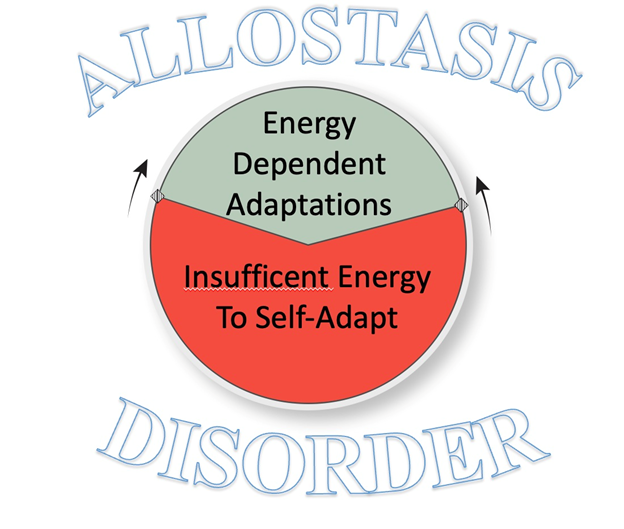
Figure 1 An illustration depicting the limited extent to which Nature can self-respond to changed environmental conditions using energy-dependent allosteric adaptations. Additional sources of energy are required to bring a discorded, energy-insufficient, environment, back past the tipping points (
 ) into the zone of self-correcting allostasis. KELEA, indicated by the arrows, can potentially provide this energy, especially through its water-activating actions. Only minimal amounts of KELEA may be required to initiate the self-healing proces.
) into the zone of self-correcting allostasis. KELEA, indicated by the arrows, can potentially provide this energy, especially through its water-activating actions. Only minimal amounts of KELEA may be required to initiate the self-healing proces.
KELEA & the ACE Pathway
KELEA (Kinetic Energy Limiting Electrostatic Attraction) is the driving force for the alternative cellular energy (ACE) pathway.9–13 This pathway differs from the cellular energy obtained by metabolism from the calories in consumed food. Water can be used to transfer environmental KELEA for use by all life forms.14–19 Certain devices and materials that create fluctuating electrical charges can help initiate the local KELEA activation of water. If sufficient local activation of the water is achieved, the process will extend to involve adjacent water in a continuing expanding process.14–17,20–22
An effective, yet inexpensive means of initiating water activation is volcanic rock material that is formed into small pellets after being pulverized into a fine powder and heated to around 1,200o Celsius. These pellets are marketed under the name Kiko. Five to ten pellets are typically used in conjunction with small amounts (5 to 20 pounds) of biochar, which is included to absorb toxins precipitated from the loosened water molecules. A mineral and amino acid supplement is also included in the basic protocol to potentially help revive dormant beneficial microbes.
Restoring Nature’s allostasis
Illustrated descriptions of the ecological benefits of enhancing the KELEA level of two polluted environments are included below. The first is one of the more polluted sloughs (tidal basins) of Spirit Lake in Iowa. The water in the Sandbar Slough has restricted connections to the lake through several narrow channels. This slough emits the foul smell of hydrogen sulfide and is consistently largely covered was toxic algae. This was so on July 27, 2023 (Figure 2). On that day, two permeable burlap bags each containing approximately 15 pounds of biochar and six Kiko pellets, were added to the water in one of the narrow water channels leading to the lake (Figure 3). By July 30, 2023, the algae at the treated site and even extending to the water under a nearby bridge had largely disappeared, with a significant lessening of the unpleasant odor ((Figure 4) An even more major transformation of the slough was seen on revisiting the area on November 8, 2023 (three and a half months later). There was a beaver dam at the site of the Kiko-biochar application (Figure 5). Muskrat mounds were present, as were bullfrogs. The improved water quality extended throughout the slough with many geese on the water. A resident of the area could not recall seeing any beaver or muskrat activity in this region over the last 25-30 years.
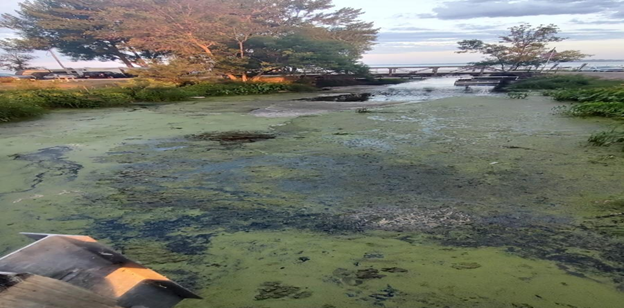
Figure 2 A wide-view photograph of the Sandbar Slough of Spirit Lake, Iowa taken on July 27, 2003. It shows extensive algae contamination, which in some other areas was multicolored. The rotting egg smell of hydrogen sulfide was very noticeable.
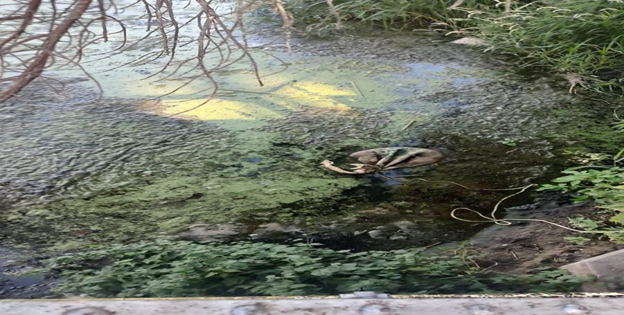
Figure 3 One of two canvas bags, which each contained three Kiko pellets and approximately 10-15 pounds of biochar. Both bags were thrown into one of the small channels connecting the Sandbar Slough to Spirit Lake. The photo was also taken on July 27, 2023.
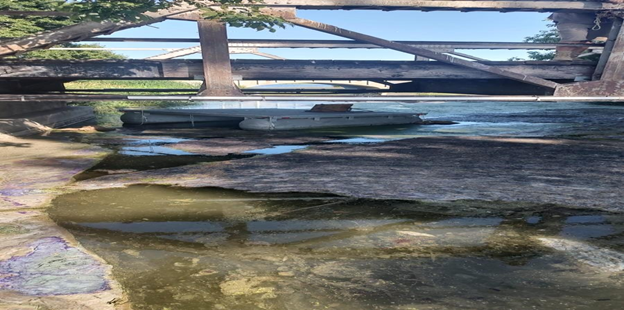
Figure 4 A photo taken on July 31, 2023. It showed a marked reduction of the algae throughout the entire slough. Moreover, there was an elimination of the hydrogen sulfide smell, and the water was clearer.
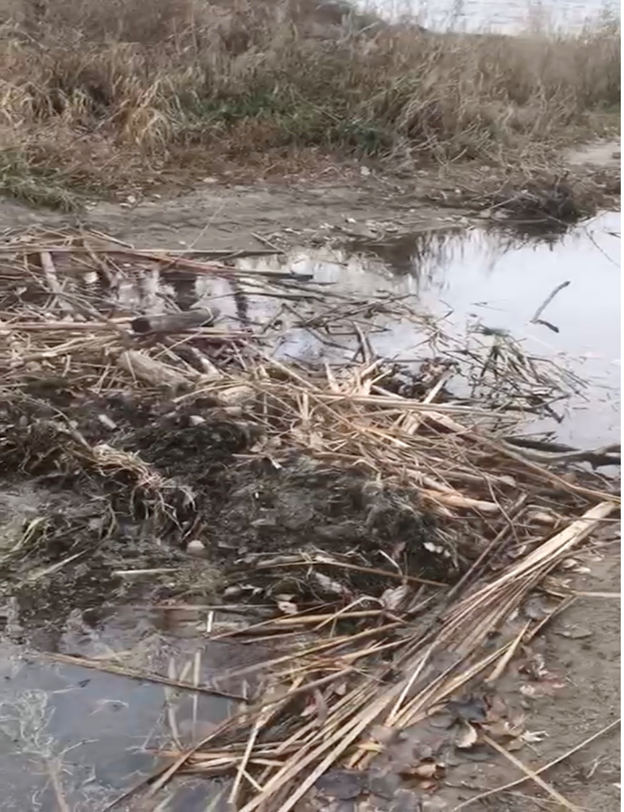
Figure 5 A beaver dam seen on revisiting the site on November 8, 2023. The dam was built at the site of the same small channel, into which the Kiko plus biochar had been applied.
Five other Spirit Lake sloughs have since been treated with Kiko pellets, biochar, and the further addition of the mineral and amino acid nutrient solution. This has led to visible improvements in the water in the treated areas. Moreover, there have been recent sightings of several types of wildlife animals, which have only been occasionally seen in the last several decades. Newly observed wildlife including daytime sightings of muskrats, multiple bald eagles, and even a moose (Figures 6A-6C). Of note, crayfish have also been observed in the water (Figure 6D). These are the natural predators of the larvae of zebra mussels.23 Additional observations are ongoing.
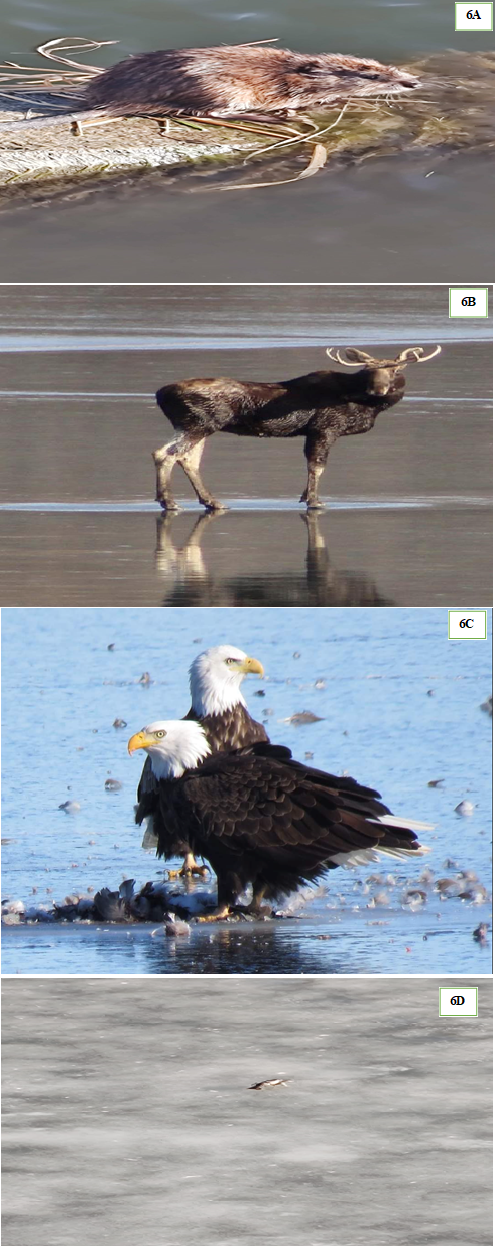
Figure 6 (A-D) Unusual sightings of wildlife seen nearby to some of the additionally treated regions of the wetlands of Spirit Lake. A. Muskrat, B. Moose. C. Bald eagles. D. Magnified photo of a crayfish. The photos were taken in December 2023.
The second example is a dramatic transformation of an unsightly lagoon located at Crown Memorial State Beach in Alameda California. Except for occasional brief periods, the lagoon has been continually contaminated with algae for several years (Figure 7). There was also an unpleasant smell to the water. The inferior condition of the water was generally attributed to inadequate water exchange with the water in San Francisco Bay.
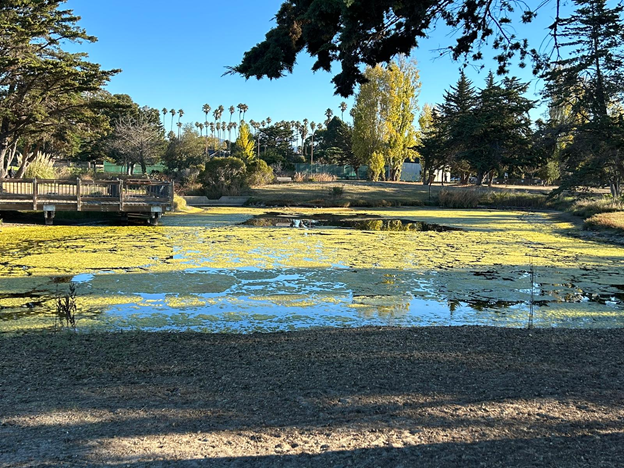
Figure 7 Photograph of a section of the lagoon at the Crown Memorial State Beach in Alameda. The rather stagnant and smelly water in the lagoon has been an unattractive feature with only occasional periods in which the water has not been contaminated with toxic algae. A wooden walkway is shown on the left side of the photo.
Several small packages of biochar mixed with a total of six Kiko pellets were thrown into the lagoon from the wooden walkway on November 18, 2023 (Figure 8). The site was revisited 12 days later (November 30, 2023). Algae were no longer visible in the lagoon, which had also lost its unpleasant smell. A duck was seen swimming in the water near the wooden walkway (Figure 9). There were even more ducks in a communicating adjacent water region, which had become cleared of algae (Figure 10).
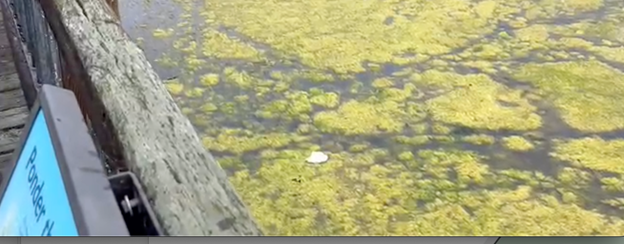
Figure 8 One of several small pouches containing several Kiko pellets and biochar, which were thrown from the wooden walkway into the water. The pouch landed on the algae.
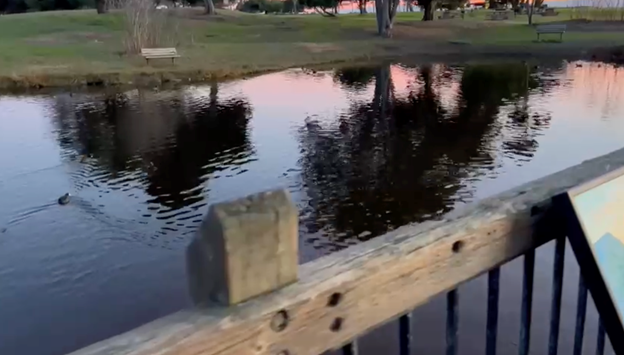
Figure 9 The same region of the lagoon was photographed 12 days later. The photo shows complete clearance of the algae and a swimming duck. The unpleasant smell of the water was no longer present.
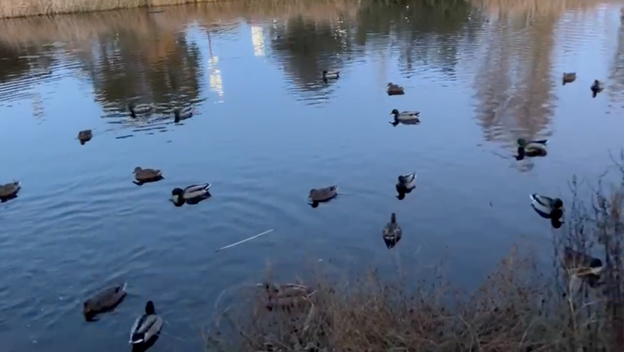
Figure 10 Photograph also taken on day 12, of a contiguous region of the lagoon, which was beyond the water that was shown in Figure 9. It too had been contaminated with algae. It shows an abundance of ducks.
Additional locations of algae-contaminated water in Alameda County have been more recently treated with similar marked improvements. These include water holes in a local golf course. A simple approach exists to reinvigorate natural allostasis in otherwise overwhelmed ecosystems throughout the world.
Potential foundational role of beneficial microbes
It is interesting but not necessary to trace the exact sequence of the restorative events occurring in the treated ecosystems. Empirical data are consistent with an early rebalancing of the microbial populations in favor of beneficial microbes. KELEA activated water may have differential effects on normal versus pathogenic microbes. For example, the acquired metabolic features leading to pathogenicity may render these bacteria more susceptible to osmotic challenges associated with the increased permeability of KELEA activated water. The metabolic pathways operating in pathogenic bacteria may not utilize an influx of KELEA as well as their normal counterparts. Microbes play a major role in the bilateral transformation between inorganic and organic compounds. They are perceived as foundation members of many developing biological ecosystems. The organic products that they produce promote the growth of numerous small plants and animals. These, in turn, collectively promote the growth of many types of larger plants and animals. Conversely, beneficial microbes, including fungi and bacteria, participate in the reconversion of organic molecules to inorganic molecules. When fully developed, there are likely to be thousands of interdependent life forms maintaining optimal cooperative interactions.
Additional means of increasing the local levels of KELEA
Comparisons are underway with other simple means of increasing the levels of KELEA in collections of water, which has gone beyond Nature’s capacity for self-repair through allostasis. In addition to heated pulverized and pelleted volcanic materials, various dipolar compounds can be used to increase the KELEA level of fluids, including water. Particularly noteworthy, is that certain naturally occurring crystals and perovskite structured compounds can transfer KELEA to nearby water without the need for direct immersion into the water. This is consistent with KELEA being a radiating force that can act over a distance. Similarly, pouches and other containers of KELEA activated water can be placed near to water that is intended to be activated. Devices that provide fluctuating and oscillating electrical charges and/or electromagnetic impulses can also achieve heightened localized levels of KELEA. The diversity of potentially effective water-activating methods will help minimize the costs of treating polluted water.
Possible health consequences
Regions of Spirit Lake are regularly posted with advisory signs to avoid swimming or eating caught fish. Doing so can cause illnesses, which are attributed to toxins and/or pathogenic microbes. It is uncertain how thorough the water treatment methods are to provide safe drinking water or optimal water for local irrigation. Conversely, consuming or otherwise using KELEA activated water is associated with major health benefits.24–27 Indeed, illnesses result when functional impairments exceed the body’s capacity for allosteric adjustments. It may well be expected, therefore, that human communities living near KELEA-enhanced waterways will experience added health benefits even beyond the removal of pollutants.
Additional applications
Enabling Nature to utilize its intrinsic capacity to adapt to altered circumstances through allostasis has many ramifications in improving other aspects of the environment. The overuse of synthetic fertilizers and pesticides along with the accumulation of industrial wastes have deranged many agricultural lands leading to a lowered nutritional value of harvested food crops. Increasing the levels of KELEA in the groundwater may initiate a series of restorative adjustments, probably again beginning with the re-emergence of beneficial microbes. Pretreating soils with Kiko pellets led to a significantly higher yield of rice when compared to non-treated soils.28 Biochar is also finding increasing use as a natural soil amendment. As shown in Spirit Lake, allosteric soil adjustments may occur in progressive stages, which require time to become fully effective. A further likely outcome is an increase in the carbon content of the improved soils, which would presumably lead to lowered atmospheric carbon.
As reported elsewhere, “KELEA assisted restoration of Nature’s Allostasis (KARNA)” can be utilized in other environmentally supportive processes. It reduces the specific heat capacity of water with less energy required to create steam to run turbines. It also allows for more efficient heat transfer in HVAC systems.29 Water pipes carrying KELEA activated water are less prone to scale formation. As a source of chemical energy, KELEA can improve fuel efficiency and lead to more complete combustion.30,31 There are, therefore, many benefits of ensuring an adequate KELEA content of the world’s waterways.
Mr. James Osugi Chairman of Kiko Technology Limited, registered in Hong Kong SAR, provided the Kiko pellets and directions for their use. Mr. Steve Gruhn is an executive in the corporation that provided the biochar. He lives near the Big Spirit Lake and selected the first site to apply Kiko plus biochar. Mr. Dave Sybesma of D&K Investments has treated the other five sites on the lake. He has also supplied the mineral water solution. Research on KELEA and the ACE Pathway is supported by MI Hope Inc., a non-profit public charity. One of the missions of MI Hope Inc. is to help in the compiling and reporting of data relating to clinical, agricultural, and industrial applications of KELEA. Information on KELEA is available in the cited references.
None.
The author declares no conflict of interest in writing the manuscript.

©2024 Martin. This is an open access article distributed under the terms of the, which permits unrestricted use, distribution, and build upon your work non-commercially.